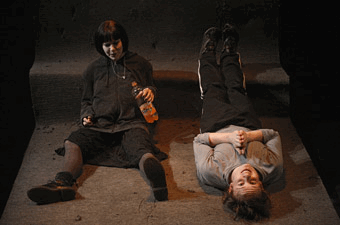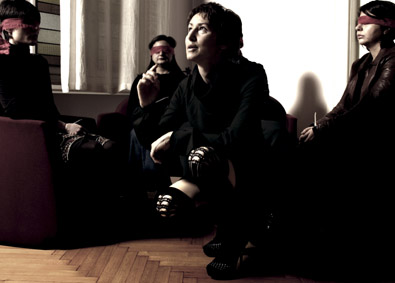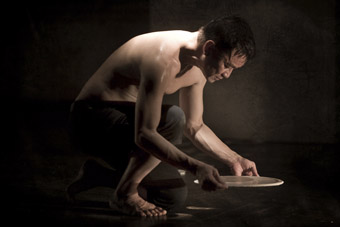see you, see me
john bailey: recent melbourne theatre and dance

Sarah Ogden, Dylan Young, Moth, Malthouse Theatre and Arena Theatre Company
photo Jeff Busby
Sarah Ogden, Dylan Young, Moth, Malthouse Theatre and Arena Theatre Company
AT THE TIME OF WRITING, THREE PUBLIC DEBATES ARE RICOCHETING AROUND MELBOURNE: THE ALLEGED INVASION OF PRIVACY ENACTED BY SOCIAL MEDIA SITE FACEBOOK; THE “DON’T ASK, DON’T TELL” COMMENTS BY AN AFL FOOTBALLER REGARDING HOMOSEXUALITY IN THE SPORT; AND THE TROUBLING NATIONAL CALL TO “BAN THE BURQA.”
Though no one has, as yet, articulated any link between these issues, it strikes me that a common thread connects them: the right to choose how much of ourselves we reveal to others, and the ways in which we do so. Is society eroding distinctions between public and private, with ‘transparency’ (that loathsome term so favoured by government and big business alike) used to justify an increasingly Foucaultian surveillance of citizens? Maybe. Thankfully I can take these thoughts to the theatre, where the politics of the gaze and the power of the audient can be explored under more controlled conditions.
malthouse & arena: moth
At the centre of Moth, the latest production between Arena Theatre and Malthouse Theatre, is a moment of violence that speaks directly to these concerns. There is an assault, but the true savagery stems less from the physical harm inflicted than the fact that it is filmed on a mobile phone and uploaded to the internet. We watch the two teenage victims reliving their pain as unwilling spectators themselves, party to the comments of schoolmates splaying out beneath the endlessly repeatable footage. It’s a peculiarly postmodern horror that is compounded by their own complicity—in assuming the position of witness to their own bullying, they soon take on the role of bully themselves and turn upon each other.
There’s far more to Moth than this—it’s an outstanding character study inspired by tragic real events, as well as a finely crafted example of collaborative theatremaking at its best. Declan Greene’s script digs deeply into the monstrous dynamics of high school life that many of us have probably repressed (for good reason); it’s almost assured that any audience member will leave with an enriched, if unsettling, understanding of the frightening world today’s teenagers inhabit. It’s also a superbly performed work, with Dylan Young especially creating a compelling and complex anti-hero.

Roberta Bosetti, The Persistence of Dreams: The Sandman, IRAA Theatre
photo Umberto Costamagna
Roberta Bosetti, The Persistence of Dreams: The Sandman, IRAA Theatre
iraa: the persistence of dreams:
the sandman
The gaze is turned upon the audience in IRAA Theatre’s The Persistence of Dreams: The Sandman. A pair of strangers enter your home; after guiding them through the dwelling you are seated and a performance, of a sort, begins. Into the dialogue creep telling references to a range of intertexts that explore the breakdown of social norms and domestic security—Michael Haneke’s Funny Games, David Lynch’s Blue Velvet, Cormac McCarthy’s The Road. Soon enough you find yourself involved in just such a violation, subjected to a mild but provocative series of acts that put you in the role of object rather than voyeur. The fact that the experience is shared—you must gather between six and 12 fellow travellers—adds to this a sense of shared subjugation.
The work’s title alludes to the ETA Hoffmann short story which prompted Freud’s theories of the uncanny, and the experience itself literalises this notion as an incursion of the unfamiliar into the known. It’s not a terrifying experience, and neither is The Persistence of Dreams, but it does have a haunting effect enhanced by the manipulation of your home’s lighting and the rearrangement of the items in your living space. Most tellingly, once the strangers had departed, I found myself discussing for several hours with my fellow guests exactly what had just occurred, as if to dispel some lingering phantom and seek through words the return of the familiar.
jo lloyd’s 24 hrs, dancehouse
A recent Jo Lloyd project commissioned by Dancehouse offered a less threatening form of meditation on the way the makers of art modulate what is shown and kept hidden. 24 Hrs saw four choreographers each given a 24-hour period in which to develop a work from scratch, presenting the new performance at the conclusion of the allotted time. Much of the development was recorded on video and streamed online, where audiences could join in discussions of what they were seeing and become active commentators.
Though I could only make it to the first two presentations of 24 Hrs I found in them a marked contrast. Natalie Cursio’s work was a messy installation of recycled waste in which a series of fertile scenarios sprouted. The three dancers worked around clear moments in which power dynamics shifted or relationships reformed themselves; within this framework there was still a loose sense of play and spontaneity which tapped the tight time restrictions to produce a charming liveliness. In a post-show forum Cursio was asked whether the piece would go on to have a further life in some form, but all present seemed to agree that its transience was key to its meaning.
Shelley Lasica’s work the following week—also for three dancers—had a similar air of improvisation within boundaries, but for me didn’t raise the range of questions Cursio’s work inspired. It appeared more a formal exercise in technique, admirable in that respect, but not making the conditions in which it was produced a part of its own investigation. It was a work that could easily be seen as the starting point for a later, more developed project, but this meant that on its own it seemed too much a performance in embryonic form rather than something complete and contained in its own right.
Both pieces did allow audiences to contemplate the exposed mechanics of creation, but does viewing fragments of a work in progress and hearing the thoughts of makers on the fly add to or subtract from our experience of the final result? I don’t know the answer. It simply offers a different experience with its own rewards and disappointments. I certainly wouldn’t want the bones of every production revealed, since one of the joys of art is the possibility of encountering something magnificently realised from a position of innocent ignorance. Conversely, most forms of aesthetic production emerge from a process in which artists select those things they wish to reveal and attempt to control other functional elements. Pay no attention to the man behind the curtain.

Tony Yap, Rasa Sayang
photo Jave Lee
Tony Yap, Rasa Sayang
tony yap, rasa sayang
None of this is new. The contract between a performer and their audience has always possessed its variable clauses of revelation and reticence, knowing and guessing, curiosity and blindness. There is an uncomplicated pleasure in being offered something that doesn’t claim a raw, unmediated transparency but is the result of careful crafting and modulated reticence. One such offering was Tony Yap’s Rasa Sayang, a small but exquisite solo dance accompanied by a live score by Tim Humphrey and Madeleine Flynn.
Before the performance began, Yap was among his audience, conversing with animation, but once the lights dimmed he entered a state of precisely controlled expression that channelled great emotions into tiny gestures. Much of the work seemed to work through memories of Yap’s mother and the intimacy of memory, regret and grief, but this was not an autobiographical work. That only brief, at times abstract details, of this relationship were unveiled didn’t obscure the effects of the piece but broadened them, allowing Yap’s audience space within which to introduce their own experiences and understanding of family and distance. Though not an overt subject of the work, this necessary reciprocity in any act of performance will always inform its shape and significance; when we look at another, we may also be looking at ourselves.
Arena Theatre & Malthouse Theatre, Moth, writer Declan Greene, director Chris Kohn, performers Sarah Ogden, Dylan Young, design Jonathan Oxlade, lighting Rachel Burke, composer Jethro Woodward; Tower Theatre, CUB Malthouse, May 13-30; IRAA Theatre, The Persistence of Dreams: The Sandman, created & performed by Roberta Bosetti & Renato Cuocolo; various locations, April 7-May 7; 24 Hrs, curator Jo Lloyd, choreographers Natalie Cursio, Shelley Lasica, Phillip Adams, Luke George; Dancehouse, April 30 – May 21; Tony Yap Company, Rasa Sayang, creator, performer Tony Yap, composers Tim Humphrey, Madeleine Flynn; fortyfivedownstairs, Melbourne, April 22-25
RealTime issue #97 June-July 2010 pg. 29






